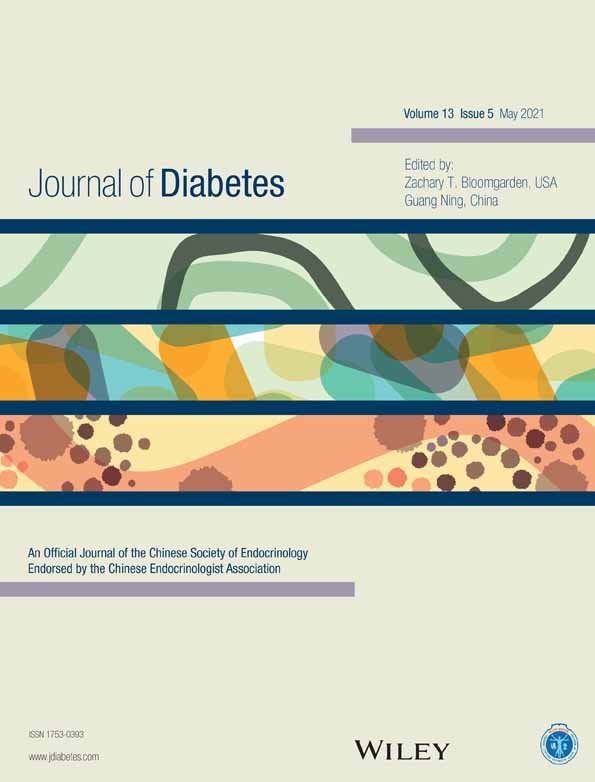Glycemic treatment: Further concepts
降血糖治疗:进一步的概念
Baseline data from 3108 participants in the GRADE (Glycemia Reduction Approaches in Diabetes: A Comparative Effectiveness Study) with type 2 diabetes of <10 years duration treated with metformin monotherapy showed that age and duration had little correlation with glycosylated hemoglobin (HbA1c), insulin sensitivity, or insulin secretion; that BMI, the ratio of triglycerides to high-density lipoprotein, metabolic syndrome, and insulin secretion were highly correlated with one another; that HbA1c had negative correlation with insulin secretion and with the disposition index (calculated as 100*((I30/I0)−1)/(G30−G0)); and that Black/African Americans have higher HbA1c compared with Whites for similar blood glucose levels.1 Although these findings confirm many prior studies, the analysis of this large dataset suggests the potential for physiologic measurement-guided diabetes treatment, for which the findings of the GRADE with a dipeptidyl peptidase IV inhibitor (DPP-IVi), a glucagon-like peptide 1 receptor agonist (GLP-1RA), insulin, and a sulfonylurea will be of interest. An outstanding question pertains to whether obesity is a major mediator of adverse outcome of coronavirus disease 2019 (COVID-19)2, 3; a recent study of persons admitted to intensive care with COVID-19, however, suggested no difference in measures of inflammatory response or in outcome between obese and nonobese persons.4 Given the apparent relationship of diabetes to COVID-19 severity and prognosis, a welcome contribution is the recent proposal of classification of the various presentations of hyperglycemia occurring in the context of the infection, with Misra and coworkers suggesting that mild hyperglycemia should be seen as occurring with prediabetes or well-controlled diabetes with mild infection, while severe hyperglycemia, sometimes with ketoacidosis, may be induced by stress, cytokines, or glucocorticoids in severe illness, with or without preexisting diabetes, and if the latter is the case may (infrequently) reflect new-onset diabetes, either from viral, immune, or pancreatitis-induced beta cell destruction.5
In a comparison of 90 094 propensity score-matched persons with type 2 diabetes over age 65 initiating sodium glucose cotransporter 2 inhibitors (SGLT2i) (predominantly canagliflozin) or GLP-1RA (predominantly liraglutide) and followed for an average of 8.5 and 5.5 months, respectively, the former were associated with similar likelihood of major adverse cardiac events (MACE), myocardial infarction, stroke, or cardiovascular death, with lower likelihoods of hospitalization for heart failure (approximately three per 1000 person-years) and acute kidney injury, and with greater likelihoods of genital infections and ketoacidosis. Worrisomely, lower extremity amputation occurred significantly more often in the SGLT2i group (approximately once per 1000 person-years), raising the question of whether this outcome should continue to be a concern with these agents.6 Addressing the relationship of outcome to age, a meta-analysis of 26 observational studies of 1 325 493 persons with diabetes concluded that earlier identification of persons with diabetes is crucial for prevention of adverse outcome, as each 1-year increase in age at diabetes diagnosis was associated with 4%, 3%, and 5% lower risk of all-cause mortality, macrovascular disease, and microvascular disease, respectively, the caveat being that the risks were adjusted for patient age, which is among the strongest risk factors for adverse outcome, thereby reducing the risk attributed to diabetes.7 Certainly glycemia is another risk, and a contribution from the Diabetes Control and Complications Trial/Epidemiology of Diabetes Interventions and Complications (DCCT/EDIC) cohort undertook to analyze equivalences of age or diabetes duration vs HbA1c: for cardiovascular endpoints, a 1% higher HbA1c equated to ~4.5 years greater age or ~6 years longer diabetes duration; for mortality, to 13 years greater age; for proliferative diabetic retinopathy, to 6 years greater age; and for macroalbuminuria and reduced estimated glomerular filtration rate (eGFR), to 15 and 18 years greater age, respectively.8 In a community-based cohort of 33 637 persons with diabetes, each 1% elevation in HbA1c was associated with a 12% increase in likelihood of cellulitis, with evidence of association of higher HbA1c with respiratory infection as well.9 As a caution, however, a recent case series reported four persons with improvement in HbA1c from 11%-14% to 6%-7%, followed by a 30% to 50% reduction in eGFR over the subsequent 1 to 2-year period, similar to the potential of rapid improvement in glycemia to exacerbate retinopathy and neuropathy.10 Certainly, severe hypoglycemia is associated with undesirable effects and should particularly be avoided with high cardiovascular disease (CVD) risk, with another population study showing significant association with CVD events, even when adjusted for multiple medical and socioeconomic factors.11
A recent comprehensive review of approaches to hospital management of hyperglycemia raised some useful concepts pertaining to the important topic of use of non-insulin drugs, noting that practice guidelines recommending that only insulin be used in hospital should be considered outdated, while recognizing issues with hypoglycemia from sulfonylureas, ongoing evidence that metformin administration may be associated with lactic acidosis in at-risk persons, and the recommendation that SGLT2i be withheld 3 to 4 days before surgery because of risk of ketoacidosis, but, importantly, pointing out some questions about appropriate treatment approaches. Do DPP-IVi, which appear to be associated with reduction in hypoglycemia in hospitalized persons, also have survival benefit for patients with COVID-19? Does the better glycemic control in hospital with the combination of a GLP-1RA and basal insulin outweigh gastrointestinal side effects? And, most important, does the clinical trial evidence of reduction in MACE with outpatient use of SGLT2i and GLP-1RA translate into in-hospital benefit12?
在糖尿病患者降糖方法的疗效比较研究(GRADE)中,接受二甲双胍单药治疗的3108名2型糖尿病患者的基线数据显示,年龄和病程与糖化血红蛋白(HbA1c)、胰岛素敏感性或胰岛素分泌几乎没有相关性;体重指数(BMI)、甘油三酯与高密度脂蛋白的比值、代谢综合征和胰岛素分泌之间高度相关;HbA1c与胰岛素分泌和倾向指数呈负相关。在血糖水平相近的情况下,黑人/非裔美国人的HbA1c高于白人。虽然这些发现证实了许多先前的研究,但对这一大型数据集的分析表明了生理学测量指导糖尿病治疗的潜力,在GRADE研究中发现使用二肽基肽酶IV抑制剂(DPP-IVi)、胰高血糖素样肽1受体激动剂(GLP-1RA)、胰岛素和磺脲类药物的结果将令人感兴趣。一个悬而未决的问题是:肥胖是否与COVID-19的不良后果有关?最近一项对COVID-19重症监护患者的研究表明,肥胖和非肥胖者在炎症反应指标或预后方面没有差异。鉴于糖尿病与COVID-19严重程度和预后的明显关系,最近有学者提出在感染的背景下,可以对高血糖的各种表现进行分类,糖尿病前期或控制良好的糖尿病合并轻度感染时可出现轻度高血糖;无论是否有糖尿病,应激、细胞因子或重症疾病时使用糖皮质激素,都会造成严重高血糖,有时还伴酮症酸中毒。如果既往没有糖尿病,则可能反映的是病毒、免疫或胰腺炎诱导的β细胞破坏而出现的新发糖尿病。
在对90 094名年龄在65岁以上、倾向得分匹配的2型糖尿病患者的研究中,患者开始服用葡萄糖协同转运蛋白2抑制剂(SGLT2i)(主要是卡格列净)或GLP-1RA(主要是利拉鲁肽),并分别平均随访了8.5个月和5.5个月,发现患者发生主要不良心脏事件(MACE)、心肌梗死、卒中或心血管死亡的可能性相似,但前者因心力衰竭住院的可能性较低(约每1000人中有3例),急性肾损伤,生殖器感染和酮症酸中毒的可能性更大。令人担忧的是,在SGLT2i组中,下肢截肢的发生频率明显更高(大约每1000人年一次),这引发了这样的问题:这些药物的结果是否应该继续受到关注。关于结果与年龄的关系,对1325493名糖尿病患者进行的26项观察性研究的meta分析得出结论,及早发现糖尿病患者对于预防不良结果至关重要,因为糖尿病诊断年龄每增加1岁,可以降低全因死亡率4%、大血管疾病变3%和微血管病变5%的风险。血糖必然是另一个风险,来自DCCT/EDIC(糖尿病控制和并发症试验/糖尿病干预和并发症流行病学)队列的一项研究致力于分析年龄或糖尿病病程与HbA1c的等效性:对于心血管终点,HbA1c增加1%相当于年龄增加约4.5岁或糖尿病病程延长约6年;对于死亡率,相当于年龄增加13岁;对于增殖性糖尿病视网膜病变,相当于年龄增加6岁;对于大量蛋白尿和估计肾小球滤过率(eGFR)降低,相当于年龄增加15岁和18岁。在一项以社区为基础的33637名糖尿病患者队列研究中,糖化血红蛋白每升高1%,患蜂窝组织炎的可能性增加12%,同时有证据表明糖化血红蛋白升高也与呼吸道感染有关。然而,值得注意的是,最近的病例报告有4人的HbA1c从11%-14%改善到6%-7%,在随后的1到2年内EGFR下降了30%到50%。这与血糖迅速改善反而加重视网膜病变和神经病变相似。当然,严重的低血糖与不良反应相关,尤其应该避免发生心血管疾病(CVD)的风险,一项人群研究显示,即使在调整了多种医疗和社会经济因素后,这也与CVD事件显著相关。
最近一项综述全面回顾了医院治疗高血糖的方法,提出了一些与使用非胰岛素药物这一重要主题有关的有用概念,指出在医院只使用胰岛素的实践指南应该被认为是过时的,同时需要认识到磺脲类药物引起的低血糖问题,持续的证据表明二甲双胍治疗可能与高危人群的乳酸酸中毒有关,建议为了避免酮症酸中毒,在手术前3-4天不使用SGLT2i。此外重要的是指出了适当治疗方法的几个问题:可能与降低住院患者低血糖有关的DPP-IVi对COVID-19患者是否也有生存益处?联合应用GLP-1RA和基础胰岛素的医院血糖控制效果收益是否大于造成的胃肠道副作用?最重要的是,门诊使用SGLT2i和GLP-1RA减少主要不良心脏事件的临床试验证据是否已经转化为住院收益?




